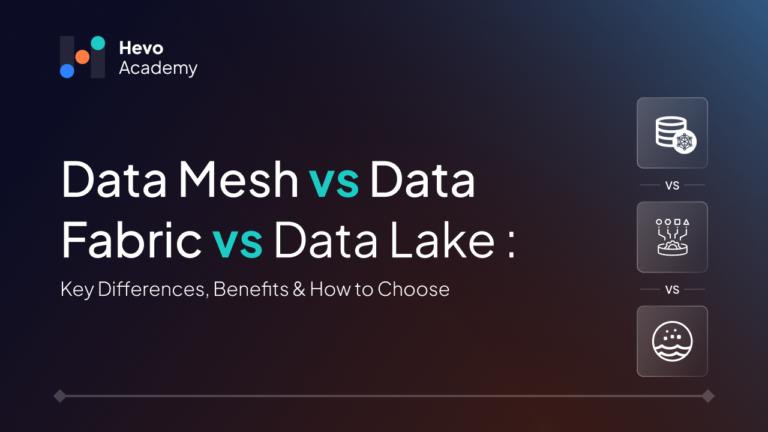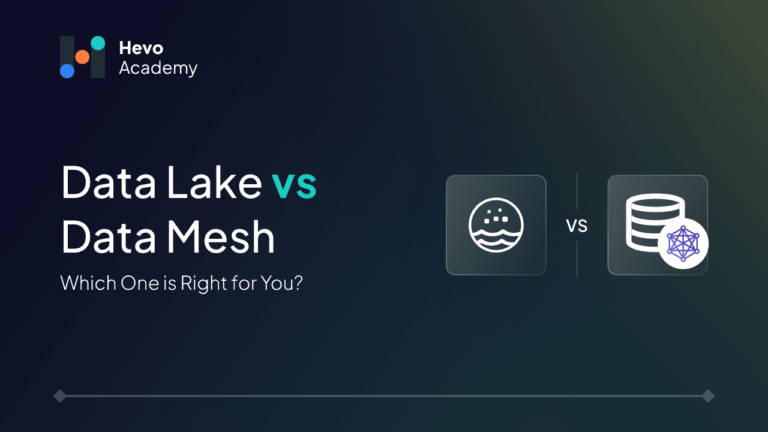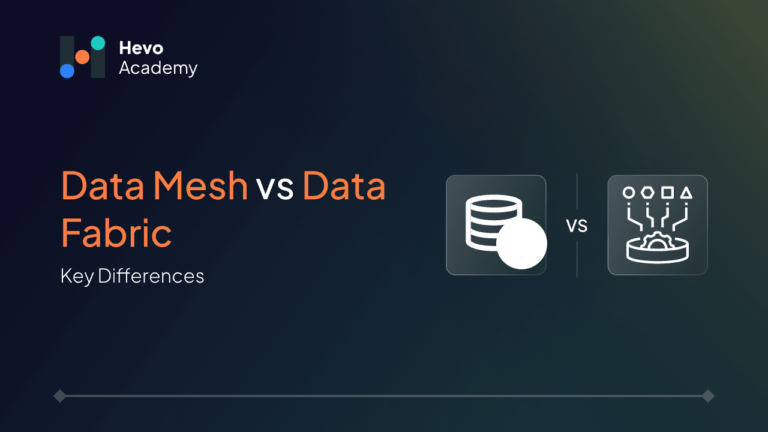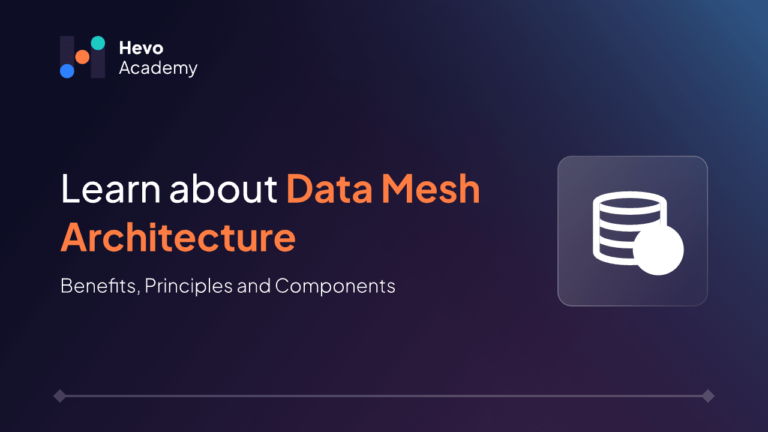One question that often comes up in the data community is: Data Mesh vs Data Fabric vs Data Lake. Everyone’s trying to figure out which architecture is the best fit for their organization. While many companies aim to be “data-first,” not all data architectures offer the same level of democratization and scalability.
You ask, what could possibly go wrong? Well, an inappropriate data architecture results in inefficiencies, data silos, and lost opportunities.
For instance, if your company relies heavily on real-time analytics, you need an architecture that delivers low-latency insights from streaming data. Here,
Table of Contents
- A data fabric can be implemented to offer a real-time data pipeline, so that the processing and analysis of data as it is generated.
- Data Mesh can be used for real-time analytics but might require additional tools and infrastructure.
- Data Lake is not well-suited for real-time analytics, as it’s primarily designed for batch processing.
While there is no one-size-fits-all solution, your organization’s data architecture depends on your specific requirements, data maturity, and organizational culture.
Let’s dive into the article to determine which data architecture—Data Mesh, Data Fabric, or Data Lake—fits best.
What is Data Mesh?
Data Mesh is a modern approach to data management that decentralizes data ownership. Each team or department in a company takes care of its own data. Each business domain manages its own data, ensuring that the people who understand the data best are responsible for it. Data is treated like a product, with clear ownership, quality standards, and user support. Tools and platforms enable teams to manage and use data independently while a central team sets and enforces rules.
For instance, a large retail company with departments like sales, marketing, and customer service. Traditionally, a central data team would manage all the data, causing delays and bottlenecks. With a data mesh, each department handles its own data. This means the sales team can quickly access and analyze sales data, the marketing team can work with marketing data, and so on, leading to more efficient operations.
Looking for the best ETL tools to connect your data sources? Rest assured, Hevo’s no-code platform helps streamline your ETL process. Try Hevo and equip your team to:
- Integrate data from 150+ sources(60+ free sources).
- Utilize drag-and-drop and custom Python script features to transform your data.
- Risk management and security framework for cloud-based systems with SOC2 Compliance.
Try Hevo and discover why 2000+ customers like Ebury have chosen Hevo over tools like Fivetran and Stitch to upgrade to a modern data stack.
Get Started with Hevo for FreeKey Features of Data Mesh
- As each team handles its own data, it becomes easy to scale.
- Teams can use tools and processes that suit them best, offering flexibility.
- Teams are more invested in keeping their data high-quality.
- Teams can access and use data quickly without waiting for a central team.
Take a look at the basic principles of Data Mesh to get a better understanding of the concept.
Benefits of Data Mesh
- Collaboration between teams is improved as they work closely with data relevant to them.
- There is a significant reduction in bottlenecks as delays are seen from a central data team.
- As data is more accessible and useful, your team gets better data utilization.
- With improved flexibility, your team can experiment and innovate with their data.
Take a look at the Data Mesh Tools you should use for seamless data management.
Challenges Faced with Data Mesh
- Managing multiple data domains gets complicated and complex.
- Maintaining consistency between all teams and ensuring everyone follows the same standards is tough.
- It’s expensive to implement and maintain a data mesh.
- Shifting from a traditional approach to a cultural shift requires a change in mindset, which becomes difficult when adapting to decentralized data management.
What is a Data Fabric?
Data Fabric is like a smart web designed to manage and integrate data across various platforms and environments. This makes the data easily accessible and usable in a unified manner.
For instance, think of a retail company with customer data in one system, sales data in another, and inventory data in another. Without a data fabric, accessing and analyzing this data together is difficult. However, with a data fabric, all this data is integrated and accessible in one place. This allows the company to analyze customer buying patterns and manage inventory more efficiently and quickly.
Key Features of Data Fabric
- Offers a single access point for all data, regardless of where it is stored.
- Consolidates data from multiple sources into a unified framework.
- Uses artificial intelligence and machine learning to automate data management processes.
- Makes sure that data is available in real time for analysis and decision-making.
You can check out the differences between Data Mesh vs Data Fabric to understand the clear differences between the two concepts.
Benefits of Data Fabric
- A unified data view offers visibility as a cohesive view of data from various sources, making it easier to analyze and use.
- With real-time data access, businesses can make more informed decisions.
- Strong governance and security measures protect sensitive information.
- With a reduced need for multiple data management tools, your team can save on costs.
Challenges Faced with Data Fabric
- You need to think through the planning and implementation of a data fabric.
- Integration of data from diverse data sources gets challenging.
- The initial setup and maintenance costs are expensive.
- Your team needs to hire skilled personnel to manage and maintain the systems.
What is a Data Lake?
A Data Lake is a large storage repository holding vast amounts of raw data in its native format until needed. It can be considered as a huge lake where all kinds of data flow in and are stored until someone needs to use it.
For instance, streaming services like Netflix collect data from various sources: user profiles, viewing history, ratings, and even social media interactions. All this data flows into a data lake, which is then utilized by the data scientists for analyzing and viewing patterns, improve recommendations, and create new features.
Key Features of Data Lakes
- All data is centrally stored in one place in its original form and can be accessed when needed.
- Data is stored without a predefined structure and is only structured when read.
- Accepts all types of data—structured (like databases), semi-structured (like XML files), and unstructured (like images and videos).
- Storing large volumes of data in a data lake is generally cheaper than using traditional databases. However, costs can vary based on factors like the cloud provider, data volume etc.
Benefits of Data Lakes
- Your team gets the flexibility to store and process different types of data.
- It’s scalable and can grow as your data grows.
- Lower storage costs.
- Supports big data analytics, machine learning, and real-time analytics.
Challenges Faced with Data Lakes
- Managing and securing large volumes of data is complex.
- Maintaining data quality that is clean and usable is tricky.
- Performance gets impacted when large datasets are queried and can be slow if not optimized.
- It requires specialized skills to manage, analyze, and navigate the complexity of data.
Want to dive deeper into data fabric vs data lake? Check out our blog to explore their unique capabilities and use cases.
Criteria Comparison: Data Mesh vs Data Fabric vs Data Lake
Before we dive into the details, let’s quickly see how data mesh, data fabric, and data lake stack up against each other.
| Criteria | Data Mesh | Data Fabric | Data Lake |
| Architecture | Decentralized, domain-oriented data ownership | Centralized, unified data management across systems | Centralized, store raw data in its native format |
| Scalability | Scales with organizational growth through domain teams | Scales by integrating diverse data sources seamlessly | Scales by adding more storage capacity |
| Flexibility | High flexibility with domain-specific data products | High flexibility with integrated data access | Flexible for storing all types of raw data |
| Data Integration | Integrates data within domains, promoting ownership | Seamless integration across various data sources | Integrates raw data from multiple sources |
| Data Storage | Distributed storage within domains | Centralized storage with unified access | Centralized, cost-effective storage |
| Real-Time Data Access | Supports real-time data access within domains | Provides real-time data access across integrated systems | Limited real-time access, primarily batch processing |
| Implementation Complexity | Complex due to decentralized architecture and domain-specific setups | Moderate complexity with centralized management and integration | Simpler to implement, focusing on storage and basic processing |
| Cost Efficiency | Cost-effective by leveraging domain-specific resources | Cost-effective through optimized data integration and management | Cost-effective for large-scale raw data storage |
| Top Companies Offering Solutions | Confluent, Starburst, DataStax | IBM, Informatica, Talend | AWS, Microsoft Azure, Google Cloud |
You can also take a look at data lake vs data warehouse vs data lakehouse. Check out our blog to explore their unique advantages and how they impact modern data architectures.
Detailed Comparison: Data Mesh vs. Data Fabric vs. Data Lake
In this section, we’ll dive deeper into the distinct characteristics and advantages of data mesh, data fabric, and data lake, highlighting how each approach specifically meets certain data management requirements.
Architectural Approach
- Data Mesh: A decentralized architecture where each domain (or team) is responsible for its own data. This promotes independence, enabling groups to autonomously scale and manage their data.
- Data Fabric: A more centralized approach with a virtualized layer that connects various data sources. This retains flexibility and integration capabilities while simplifying data management and access and providing a more cohesive, unified view of data.
- Data Lake: A centralized repository for storing all types of raw data. This approach can easily handle vast volumes of diverse data. Although it can become complex to manage and secure over time, as data scales.
Data Ownership & Governance
- Data Mesh: A domain-specific ownership model that ensures each team is responsible for its own data. Accountability is encouraged, and customized governance procedures that meet the unique requirements of every domain are made possible.
- Data Fabric: A centralized governance framework that provides distributed access across the organization. This methodology upholds a cohesive governance framework while permitting diverse teams to have safe and adaptable access to data.
- Data Lake: A centralized governance model that simplifies oversight but may pose difficulties in properly managing and safeguarding data, particularly as data volume and variety rise.
Use Cases & Applications
- Data Mesh: Enables every department to freely maintain and grow its own data, making it ideal for big organizations with a variety of data domains, such as multinational corporations.
- Data Fabric: Excellent for companies that require real-time integration and access, including financial institutions that need to have smooth data flow for immediate transactions and fraud detection.
- Data Lake: Perfect for businesses analyzing massive amounts of unstructured data, such as social media companies that store and examine enormous volumes of user-generated content.
Which Strategy is Right for Your Organization?
All approaches have pros and cons, but the key to picking the right one lies in understanding your particular needs.
Consider these top three factors:
- Data Complexity: If your organization has several data domains, data mesh may be the ideal option because it gives each team the freedom to manage its own data separately, which boosts scalability and flexibility.
- Real-Time Needs: Data Fabric is suitable for real-time data access and integration since it offers seamless connectivity and rapid data availability across several platforms.
- Data Volume: If you need to handle big amounts of unstructured data, a data lake is the way to go because it can store massive amounts of raw data cost-effectively.
Weigh these considerations to determine which approach best fits your organization’s goals and needs.
Also, take a look at how you can easily build an actionable data quality strategy for your data needs.
Conclusion
With the increasing complexity and volume of data, it is becoming more and more important to hand-pick the right architecture. From conventional data warehouses to contemporary data lakes and now to data mesh and data fabric, the options are diverse and always changing.
To avoid issues like data silos, integration challenges, and scalability problems, implement the data architecture that fits your organizational needs. Consider three main factors: data governance, scalability, and integration capabilities.
- Data Mesh helps teams manage their own data for faster decision-making.
- Data Fabric connects all data sources to make access and integration easy.
- Data Lake stores all raw data in one place for flexible analysis.
Given the complexity of these options, it can sometimes be confusing to decide which one to choose. That’s where HevoData experts come in. They can help you navigate these choices and make an informed decision. Connect with us to expedite your data management journey in the modern data era.
Take Hevo’s 14-day free trial to experience a better way to manage your data pipelines. You can also check out the unbeatable pricing, which will help you choose the right plan for your business needs.
FAQ
1. What is the difference between data fabric and data mesh?
Data fabric automates the integration of data across different environments, making it easier to access and manage. Data mesh, on the other hand, decentralizes data ownership, giving specific teams control over their data domains.
2. What is the difference between data fabric and data lake?
Data fabric connects and manages data from various sources, ensuring seamless access and integration. A data lake is a large storage repository that holds raw data in its original format until needed.
3. What is the difference between data mesh and data lake?
Data mesh focuses on organizing data by domain, with each team responsible for its own data governance. A data lake is a centralized storage system where all raw data is kept together, regardless of its source.
4. What is the difference between medium data mesh and data fabric?
Medium data mesh focuses on domain-specific data management, allowing teams to take ownership of their data. In contrast, data fabric aims to integrate data across the entire organization, offering a unified view and streamlined access.
5. Is Mesh better than Fabric?
Choosing between data mesh and data fabric depends on your specific requirements. Data mesh excels in domain-specific data management, empowering teams with greater control. Conversely, data fabric shines in unifying data integration across the organization, ensuring seamless access and management.





